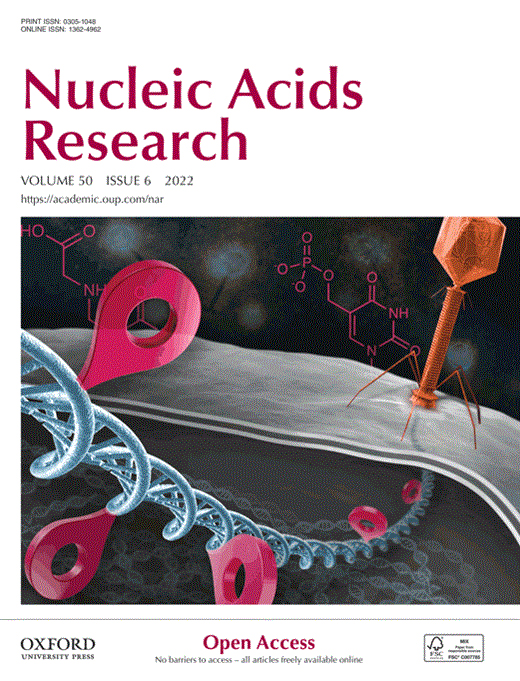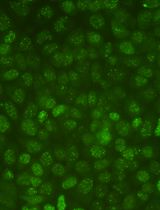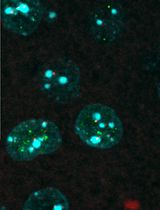- EN - English
- CN - 中文
OxiDIP-Seq for Genome-wide Mapping of Damaged DNA Containing 8-Oxo-2'-Deoxyguanosine
利用OxiDIP-Seq方法对含8-氧代-2′-脱氧鸟苷的受损DNA进行全基因组图谱分析
发布: 2022年11月05日第12卷第21期 DOI: 10.21769/BioProtoc.4540 浏览次数: 2764
评审: Istvan Boldogh Avinash Chandra PandeyAnonymous reviewer(s)
Abstract
8-oxo-7,8-dihydro-2′-deoxyguanosine (8-oxodG) is considered to be a premutagenic DNA lesion generated by 2'-deoxyguanosine (dG) oxidation due to reactive oxygen species (ROS). In recent years, the 8-oxodG distribution in human, mouse, and yeast genomes has been underlined using various next-generation sequencing (NGS)–based strategies. The present study reports the OxiDIP-Seq protocol, which combines specific 8-oxodG immuno-precipitation of single-stranded DNA with NGS, and the pipeline analysis that allows the genome-wide 8-oxodG distribution in mammalian cells. The development of this OxiDIP-Seq method increases knowledge on the oxidative DNA damage/repair field, providing a high-resolution map of 8-oxodG in human cells.
Keywords: 8-oxo-7,8-dihydro-2′-deoxyguanosine (8-氧代-7,8-二氢-2′-脱氧鸟苷)Background
DNA, as a highly dynamic molecule, is constantly exposed to mutation events (Lindahl, 1993). Among DNA mutant factors, reactive oxygen species (ROS) are the most prominent source of DNA modifications that may trigger processes such as neurodegeneration (Kim et al., 2015), ageing (Beckman and Ames, 1998), and cancer (Klaunig and Kamendulis, 2004). The 2'-deoxyguanosine (dG) is the most ROS-targeted nucleobase due to its lower oxidation potential (Steenken and Jovanovic, 1997; Baik et al., 2001). The best characterized product of dG oxidation induced by ROS is 8-oxo-7,8-dihydro-2′-deoxyguanosine (8-oxodG; Figure 1A) (Baik et al., 2001; Cooke et al., 2003; Evans and Cooke, 2004; van Loon et al., 2010). This altered base is chemically generated by C8 oxidation and subsequent addition of a hydrogen atom on the N7 in the imidazole ring of deoxyguanosine.
The 8-oxodG is considered a premutagenic DNA lesion that may bond 2′-deoxyadenosine, thus causing a dC:dG to dA:dT premutagenic transversion (Shibutani et al., 1991; Maga et al., 2007; Batra et al., 2010; Koga et al., 2013; Boiteux et al., 2017). Human cells can survive this mutational phenomenon through the base excision repair (BER), a multi-layer defence machinery (Lindahl, 1990; Lindahl and Barnes, 2000).
The OGG1 glycosylase/AP(apurinic/apyrimidinic) lyase initiates the BER pathway, specifically recognizing and removing the 8-oxodGs from the sugar backbone. The OGG1 activity creates an abasic site, which is subsequently incised by either the OGG1 intrinsic AP lyase activity, or by the AP endonuclease 1, APE1. The lyases’ activity generates a single strand DNA (ssDNA) break. Then, the short patch BER carries on with the gap filling, mediated by the DNA polymerase beta, while the long patch BER generates a 5′ overhanging flap that is removed by FEN1 (flap structure–specific endonuclease 1). Finally, the DNA ligase I (short patch) or DNA ligase III (long patch) complete the repair process by fixing the nicked strand (Frosina et al., 1996; Fortini et al., 1999; van Loon et al., 2010).
Several next-generation sequencing (NGS)–based strategies have recently been developed by different laboratories to provide a high-resolution mapping of 8-oxodG in human and mouse genomes (Ding et al., 2017; Poetsch et al., 2018; Wu et al., 2018; Amente et al., 2019; Liu et al., 2019, 2019; Cao et al., 2020; Fang and Zou, 2020; Poetsch, 2020). The previous study developed a highly sensitive methodology named OxiDIP-Seq to isolate and map oxidized DNA fragments in mammalian cells (Amente et al., 2019; Gorini et al., 2020; Scala et al., 2022). OxiDIP-Seq combines the immuno-precipitation of single-stranded DNA through specific anti-8-oxodG antibodies with NGS, with a resolution of approximately 200–300 bp (Amente et al., 2019; Gorini et al., 2020; Scala et al., 2022).
Briefly, with this methodology, genomic DNA containing 8-oxodG residues were first extracted and then fragmented by sonication. The DNA fragments were then denatured at 95 °C to expose the 8-oxodG on the single-stranded DNA. Then, the single-stranded DNA containing 8-oxodG residues was immunoprecipitated using a specific antibody targeting 8-oxodG. The so formed immunocomplexes were then pulled down through specific magnetic beads. The eluted DNA was enriched in fragments containing 8-oxodGs that can be analyzed by qPCR and/or sequenced by high-throughput sequencing (Figure 1B). In this protocol, crucial steps were carried out in low light conditions and in the presence of free radical scavengers to preserve the oxidized state of DNA extracted from cells and to prevent the introduction of possible new nonspecific 8-oxodGs during DNA handling.

Figure 1. OxiDIP-Seq technique. (A) ROS oxidation of 2′-deoxyguanosine generates 8-oxo-7,8-dihydro-deoxyguanosine (8-oxodG). (B) Schematic protocol of the OxiDIP-Seq technique.
Sequencing was performed adopting the SBS (sequencing by synthesis) chemistry and using the Illumina HiSeq 2000 platform. Reads with an average length of 50 bp were obtained. Raw sequenced data were collected in a FASTQ file and subjected to further analyses.
With the OxiDIP-Seq approach, it has been demonstrated that in the genome of normal human cells 42% of the identified 8-oxodG peaks map within gene loci, specifically in the promoter and gene body regions (Amente et al., 2019). Moreover, it has been revealed that 8-oxodG regions show a specific G4-enrichment and that there is a complex relationship between 8-oxodG and guanine–cytosine (GC) content. In particular, the promoter regions with high (>47%) GC content display low levels of 8-oxodG (Gorini et al., 2020). This suggests that other mechanisms, such as the epigenetic regulation of transcription and replication, may be involved in the accumulation of 8-oxodG (Amente et al., 2019; Gorini et al., 2020). Moreover, a set of oxidized enhancers in human epithelial cells have been recently identified and characterized, which could be classified as super-enhancers. Specifically, it has been demonstrated that these oxidized enhancers are associated with bidirectional-transcribed enhancer RNAs and DNA damage response activation. Additionally, it has been revealed that the oxidized enhancer is physically associated with promoter regions in specific CTCF-mediated chromatin loops (Scala et al., 2022).
In conclusion, the OxiDIP-Seq technique allowed us to demonstrate that 8-oxodG accumulation in enhancers–promoters regions occur in a transcription-dependent manner, providing novel mechanistic insights on the intrinsic fragility of chromatin loops containing oxidized enhancers–promoters interactions (Scala et al., 2022).
Materials and Reagents
100 mm2 plate for cell culture (Corning, catalog number: CC430167)
96-well plate for StepOnePlusTM Real-Time PCR System
Primo® filter pipette tips, 0.5–10 μL (Euroclone, catalog number: ECTD00010)
Corning® filtered polypropylene IsoTipTM pipet tips, 1–200 μL (Corning, catalog number: 4810)
Corning® filtered polypropylene IsoTipTM pipet tips, 100–1,000 μL (Corning, catalog number: 4809)
1.5 mL Eppendorf safe-lock tubes (Eppendorf, catalog number: 0030 120.086)
InvitrogenTM QubitTM assay tubes (Invitrogen, catalog number: Q32856)
PBN, N-tert-butyl-α-phenylnitrone (Sigma-Aldrich, catalog number: B7263)
DNeasy Blood & Tissue kit (QIAGEN, catalog number: 69504)
Ethylenediaminetetraacetic acid (EDTA) solution, 0.5 M in H2O (Sigma-Aldrich, catalog number: E7889)
Agarose low EEO (agarose standard) (AppliChem, catalog number: A2114)
8-hydroxydeoxyguanosine antibody (Millipore, catalog number: AB5830)
Dynabeads® magnetic beads protein G (Thermo Fisher Scientific, catalog number: 10003D)
Bovine serum albumin (BSA) (Sigma-Aldrich, catalog number: B6917-100MG)
Mini Elute® PCR purification kit (QIAGEN, catalog number: 28004)
Random primers DNA labeling system (Thermo Fisher Scientific, catalog number: 18187-013)
QubitTM dsDNA HS assay kit (Invitrogen, catalog number: Q32851)
Nuclease-free water (not DEPC-treated) (Ambion, catalog number: AM9930)
Proteinase K, recombinant, PCR grade (Thermo Fisher Scientific, catalog number: EO0492)
TruSeq ChIP library preparation kit (Illumina)
N-acetyl cysteine (see Recipes)
NaPi buffer (1 M, pH 7.4) (see Recipes)
Adjust buffer (see Recipes)
Tris EDTA (TE) buffer (see Recipes)
IP buffer (see Recipes)
Washing buffer (see Recipes)
Elution buffer (see Recipes)
Notes:
Pipette tips used in this protocol should be low-retention, RNase-free, and DNase-free, with aerosol filter. All steps have to be performed using these tips.
PCR tubes and microtubes used in this protocol should be low-retention, RNase-free, and DNase-free. All steps have to be performed using these tubes.
Optional:
MCF10A cell line (ATCC, catalog number: CRL-10317)
Dulbecco's modified Eagle medium (DMEM) (Euroclone, catalog number: ECM0728L)
Ham's nutrient mixture F-12 without L-glutamine (Euroclone, catalog number: ECB7502L)
Horse serum (Euroclone, catalog number: ECS0090L)
Hydrocortisone (Millipore, catalog number: 3867)
Cholera toxin (Sigma-Aldrich, catalog number: C8052)
Insulin (Sigma-Aldrich, catalog number: I5500)
Recombinant human epidermal growth factor (Thermo Fisher Scientific, catalog number: PHG0311)
Penicillin/streptomycin 100× (Euroclone, catalog number: ECB3001D)
Trypsin-EDTA 1× in PBS w/o calcium w/o magnesium w/o phenol red (Euroclone, catalog number: ECB3052D)
Dulbecco's phosphate (PBS) buffer saline w/o calcium w/o magnesium (Euroclone, catalog number: ECB4004L)
N-acetyl cysteine (Sigma-Aldrich, catalog number: A7250)
DNA oligos (Integrated DNA Technologies)
Luna® Universal qPCR master mix (BIOLABS, catalog number: M3003)
Growth medium for the MCF10A cell line (see Recipes)
Equipment
Qubit® 2.0 fluorometer (Thermo Fisher)
Eppendorf micro centrifuge (Eppendorf, model: 5418 R)
Diagenode Bioruptor® Plus B01020001 (Diagenode, model: UCD-300TM)
Eppendorf® Thermomixer® R dry block heating and cooling shaker (Eppendorf, catalog number: T3442)
Wide mini-sub cell GT system (Bio-Rad, catalog number: 1704405EDU)
Wide mini-sub cell GT mini handcasting kit (Bio-Rad, catalog number: 1704497)
PowerPac HC power supply (Bio-Rad, catalog number: 1645052EDU)
Vortex mixer (IKA 3340000)
PureProteomeTM magnetic stand (Millipore, catalog number: LSKMAGS08)
SavantTM SpeedVacTM DNA 130 integrated vacuum concentrator system (Thermo Fisher Scientific, catalog number: 15819206)
StepOnePlusTM Real-Time PCR system upgrade (Applied BiosystemsTM, catalog number: 4379216)
Nanodrop microvolume spectrophotometers (Thermo Fisher Scientific)
(Optional) UV crosslinker (Stratalinker, model: 1800)
Software
Fastqc
Trimmomatic
Burrows-Wheeler Aligner (BWA, version: 0.7.12-r1039, http://bio-bwa.sourceforge.net/, free)
Samtools (v1.7, http://www.htslib.org/, free)
Bedtools (v2.17.0, https://bedtools.readthedocs.io/en/latest/, free)
Deeptools (https://deeptools.readthedocs.io/en/develop/, free)
Homer (http://homer.ucsd.edu/homer/ngs/peaks.html, free)
Procedure
文章信息
版权信息
© 2022 The Authors; exclusive licensee Bio-protocol LLC.
如何引用
Gorini, F., Scala, G., Ambrosio, S., Majello, B. and Amente, S. (2022). OxiDIP-Seq for Genome-wide Mapping of Damaged DNA Containing 8-Oxo-2'-Deoxyguanosine. Bio-protocol 12(21): e4540. DOI: 10.21769/BioProtoc.4540.
分类
癌症生物学 > 基因组不稳定性及突变 > 遗传学
分子生物学 > DNA > DNA 损伤和修复
分子生物学 > DNA > 染色质可接近性
您对这篇实验方法有问题吗?
在此处发布您的问题,我们将邀请本文作者来回答。同时,我们会将您的问题发布到Bio-protocol Exchange,以便寻求社区成员的帮助。
Share
Bluesky
X
Copy link













